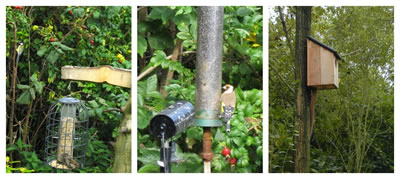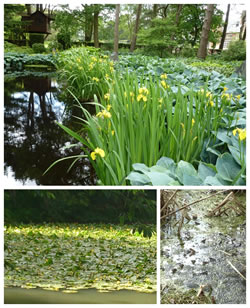
|
||||||||
Wildlife needs your help! - Create a home for nature in your gardenThe recent news that our wildlife is struggling, revealed following a study of UK wildlife which suggested that 60% of all species are in decline is worrying. This comes at a time when the EU have recently voted to ban the use of neonicotinoids on crops that are pollinated by bees following concerns over the decline of bee populations and the devastating effect that this could have on our agriculture and economy. Indeed the government has just announced it will carry out an urgent and comprehensive review of the decline of our bees. Now the Royal Society for the Protection of Birds (RSPB) is urging us to create new homes for nature in what is thought to be one of their most ambitious campaigns to date. Although this may sound like a lot of doom and gloom, it is the more familiar garden species that are suffering serious declines in numbers and this is where we, the public, through efforts in our own gardens and allotments, can help slow this decline or even reverse it. Here we have another example of my previous mantra: acting locally and thinking globally. In this article, I will share my top 10 specific suggestions for creating homes for nature in your own garden and improving your awareness of nature. This is a subject that is getting much mention at the moment, but it doesn’t just mean letting everything get overgrown! I’d like you to think you can incorporate some of the ideas, even if you want an urban or contemporary style garden with a crisp clean look: Provide shelter & food for birdsEven if there are already many suitable nest sites, a bird box may encourage a normally shy species of bird to stay on your plot. All boxes should be positioned with an easy means of access so that you can clean the box out and this should be done every autumn. Site the box on a warm, sheltered wall, trunk/post or shed, away from predators. The size of entrance hole determines which species can use the box. Bird food can include ordinary household items such as cheese, cake crumbs, fruit, porridge oats as well as good quality brands of bird food. To find out more about feeding birds, check out the RSPB information. This food is in addition to ensuring a rich mix of planting to provide seed and insects for the birds (see below).
Create diverse habitats including water for pond lifeA pond, even a tiny one, can be the focus of your wildlife oasis! A wide range of species will use it for many purposes. A pond for wildlife is best sited in a sunny position away from overhanging trees with an area of rough grass or plants along at least one edge to act as refuge and a feeding ground for amphibians. A pond in shade will support some wildlife but there will be a greater diversity in sun.
|
||||||||
| If your garden is small, a ‘fedge’ (a cross between a fence and a hedge) can be created: growing climbing plants and wall shrubs against the fence or wall. Train the plants so that the base of the support is well covered and do not trim growth back too closely. Dense evergreen climbers such as ivy or evergreen honeysuckle, provide the most effective wildlife refuges. Another idea is to train fruit to form a boundary either as a divider within the garden or as a boundary in itself for easy access by pollinating insects. | 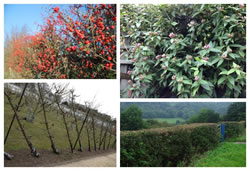 |
Consider altering the management of manicured lawns or replacing lawn/grass with species rich planting including wildflowers
For lawns to provide the best variety of habitat it is best to alternate areas of mown grass with patches of longer grass. Uncut grass can be left for example at the bases of hedges or around trees, without making the area look too untidy.
| A neat path of short-mown turf through slightly taller grass that grows next to uncut areas of vegetation can add structure to an area. When cutting areas of long grass, try not to cut it on the same day and start at one end and work inwards from one side to allow creatures an escape route. Another option is to create a wildflower meadow or a grass-free planting that is mown less frequently. Check out my latest blog: Why the grass isn’t always greener-alternatives to lawn for more information. | 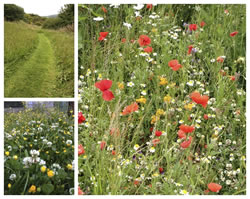 |
Provide specific herbaceous planting to attract bees, butterflies and other pollinating insects as well as birds
Modern styles of perennial planting including drifts of herbaceous planting with grasses threaded through can be a rich source of food for wildlife. Appropriate plants provide Nectar-rich food for bees & Butterflies and seedheads provide food for seed-eating birds. Leaving the heads on over winter will give birds a long-lasting ‘store cupboard’ and look stunning in the winter light covered in frost as well as providing a welcome shelter and hibernation site for insects. |
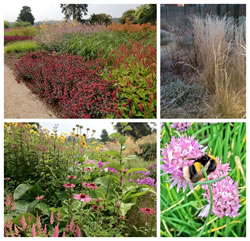 |
Provide shelter for insects and other animals - bug hotels/wildlife stacks; Bat boxes and hedgehog boxes
You can buy a whole range of purpose-built boxes for a whole range of creatures to shelter and raise a family in. The design can be incredibly simple or quite elaborate, as long as it fulfills the needs of whatever it is you are trying to attract. Hedgehog boxes can be particularly important in urban areas where shelter is scarce. The box can be sited under a hedge or thick shrub where they will be undisturbed. I love the idea of purpose built insect hotels with all manor of materials for different insects to inhabit including glass bottles, bamboo, pots, twigs etc-the only limit is your imagination and they can be a variety of sizes. At present, we are making a wildlife seat for our boutique allotment! The RSPB have some excellent information about building a wildlife stack.

Get involved with surveys of species
So that we can start to really understand what’s going on and where we need to focus efforts. Just sitting and staring at the garden might seem like doing nothing but a number of wildlife-related charities want us to do more of it. Actually, it does involve recording information and or taking pictures and uploading them, but this is straightforward and fun. This article about wildlife surveys gives more information. To inspire everyone to build homes for natures in their own gardens the RSPB has a unique website: http://www.rspb.org.uk/hfw giving everyone access to expert advice, whether it’s a huge garden or a tiny balcony. You will receive a home starter guide and can help populate their maps by telling them when and where you are giving nature a home. To help spread the word, the RSPB has joined up with Rightmove (the UK’s number one property website) to help promote the campaign to home owners and renters.
Don’t use pesticides and chemicals in the garden
It is important when thinking about wildlife not to forget that using chemicals will frequently have a knock on effect on a number of organisms, even if you think the pesticide is targeted. For example, slug pellets-easy to say only slugs eat them but remember what eats the slugs e.g. birds, frogs!! In a well-balanced wild garden you will find that the natural predators get rid of most of the ‘pests’ for you. Providing them with suitable habitat and food can encourage them. Organic gardening which I practice in the garden and allotment means taking a completely different approach to managing your garden not just changing a few sprays and fertilizers but trying to avoid using harmful pesticides and chemicals is a good start. To find out more about organic approaches, The Encyclopedia of organic gardening provides a detailed guide.
Have some areas that are managed to be less tidy!
Perhaps leave twigs; branches and plants such as nettles etc for food/shelter/hibernation –these can be managed in a particular area that fits with the ethos of that area of the garden. This may be an area tucked away for example behind the shed, or in an area at the bottom of the garden where the planting is more naturalistic. However, if there isn’t such an area, even a pile of twigs/logs can provide some benefit. A pile of logs in a shady corner will feed beetle larvae and provide food shelter for amphibians, insects, spiders and small mammals. Hedgehogs often use log piles to hibernate in. Similarly, grass clippings or other ‘waste’ material such as leaves or materials from cutting back shrubs can be used to create habitat piles around the garden. Leave windfall fruit to provide a valuable autumn food supply for insects, mammals and birds.
Create a compost heap
Composting garden waste helps your plants and wildlife. Compost makes for healthy soil; it is an excellent mulch; it is free and easy to produce; and comes without the 'fuel miles' involved in its transport. Compost heaps also provide a home for many small creatures which enjoy the heat released by the breakdown of the materials in the heap.

You can make compost in a simple covered heap at the bottom of the garden (we have one of these on our boutique allotment), but a compost box or bin looks neater and can be easier to manage. It should be sited on bare earth or grass and can be in sun or shade. The important thing it is accessible with plenty of room for adding, removing and turning material. As long as you follow a few simple instructions and approaches, composting is a straightforward process.
If you really don’t have space or the inclination for a compost heap, because you don’t have much garden waste but want to recycle kitchen scraps, perhaps consider a worm bin.
The basic requirements for all creatures are that they have food, somewhere to live and breed safely and water for drinking and bathing. Before you rush to dig a pond or put up a bat box, look around the garden and identify areas that are already attractive to wildlife and then look to other areas, that with a bit of a change in management, could be improved upon. Don’t expect too much too soon! If you want to find out more, check out this RSPB book: Gardening for wildlife.
I’d love to hear how you get on and please do follow me, Liz Ackerley (www.poppyheadconsultancy.com) on twitter @PoppyheadC or like my facebook page where I post about our current projects, garden design ideas, food growing, workshops and provide blogs on garden design-related ideas.
DISCLAIMER:
Debby's Garden Links is not responsible for the content or reliability of any websites
linked from this site, and cannot accept liability for any damage or loss arising from
reliance on such websites
We cannot guarantee that these links will work all of the time
and we have no control over the availability of the linked pages
Submit a Free Link | Advertise your Business | Privacy Policy

